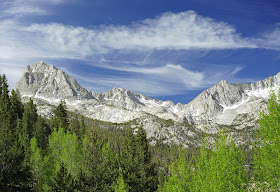Dale Matson
Click On Photographs To Enlarge
Sony Zeiss 55mm f1.8
There is an ongoing debate about prime versus zoom lenses
and I am somewhere in the middle on this, having both types of lenses. I know
that some zoom lenses are superior in image quality to some prime lenses. I also
know that some primes are actually heavier than zooms. For example, my Canon
17-40mm f4 at 1.1 pounds is lighter than the Sony Zeiss 35mm f1.4 at 1.39 pounds.
For the first two years backpacking with my Sony A7, I used
only a single lens. It was the Sony Zeiss 35mm f2.8. This combination was slick because I
could hang it off my belt in a small Lowepro camera bag. It was lightweight and
quickly accessible. Last year on a day trip in Pear Lake in Sequoia National
Park, I was faced with too much open area near a rock formation called the
Watchtower. I couldn’t bring the view closer. On that same hike, I arrived at
Pear Lake and couldn’t fit the lake with the towering granite backdrop into a
good photograph.
Since that time, I have been experimenting with lenses on
several day and extended mountain hikes. One thing I also did was review the
file data on hike photographs. When I had different options with the lenses I
had with me (both prime and zoom) what focal lengths was I selecting most
often? In terms of landscape photography, what could I add that would help me
be wider and longer than 35mm? Just how many lenses would I need at a minimum
when I am backpacking in the mountains?
This varies with degree
of access. When I can drive to a view, I can take all my lenses with me. I
think some folks who call themselves “mountain photographers” use this
approach. Many of the iconic Ansel Adams photographs were taken from the roof
of his car. On a day hike at altitude, even with thousands of feet of gain, I can still take lots of lenses but am more
selective. I still have to carry food water, GPS, Satellite phone and other
emergency gear. If only I was still young enough to be an ultra runner. It has
been said that most of Galen Rowell’s (he was a trail runner) wonderful Sierra
Nevada images could have been taken with a 24mm and 80-200mm zoom lens. He was
a minimalist on the trails. Today Leor Pantilat is the trail runner with the
camera and many of his fine photographs are from mountain peaks. I have no idea
what camera(s) he uses.
I want to also mention the issue of personal weight. There
is no point in being an ounce counter with camera and backpacking equipment if
you are above your ideal body weight. Period!
For backpacking in the high Sierras, I have three lenses for
use with my Sony A7R2. I have my walking around lens that is the Sony Zeiss
55mm f1.8. I call it my “overview lens”. I have an adapted Nikon 24mm f2.8 AIS
lens that does a wonderful wide-angle job. My short telephoto is a lightweight adapted
Contax/Yashica Zeiss 85mm f2.8 lens. I also carry a C/Y Zeiss Mutar II 2X
teleconverter for the 85mm lens which extends this lens to 170mm. With the Sony A7R2 IBIS I don't need to carry the additional weight of a tripod. This is a lightweight package for me for
mountain landscape backpacking photography.
C/Y Zeiss 85mm f2.8
C/Y Zeiss With 2X Teleconverter (170mm)
Nikon 24mm f2.8




No comments:
Post a Comment